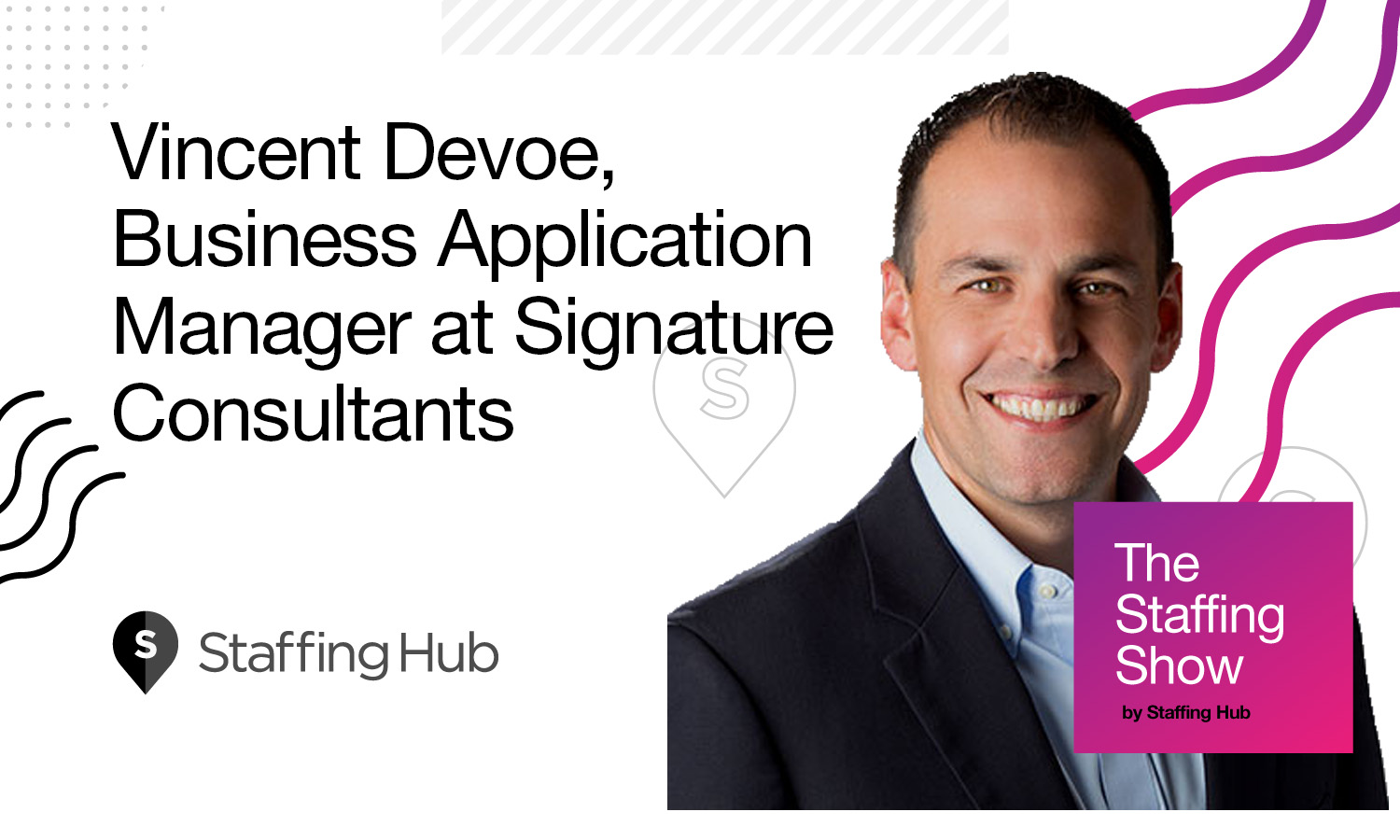
In this episode, which was recorded at this year’s Bullhorn Engage, I talk to Vincent Devoe, the Business Application Manager at Signature Consultants, about scaling a staffing firm, implementing the right technology, and measuring the success of your tech adoption.
StaffingHub: We’re in Boston at the Bullhorn Engage conference, I’m talking to Vinny Devoe, the Business Application Manager at Signature Consultants. Thanks for joining me today, Vinny.
Devoe: Thank you for having me, I appreciate it.
StaffingHub: So, you’ve been in staffing for over 20 years now and you helped grow Signature Consultants into the powerhouse that it is today. What would you say it takes to scale a staffing firm?
Devoe: The people. I’ve been with Signature for 20 years. I started off when we were four offices, about 30 employees. We now have over 27 offices and 650 employees. So, it’s been quite a ride and to see the company go from a very small organization to where we are today in a very short period of time — we haven’t been 650 employees for a very long time. Even five years ago, we were close to a couple of hundred. So, to even see it grow as rapidly as it has in the past few years, has been really awesome, to have the opportunity to be part of a company like Signature.
I would say the biggest thing for us has been, like I said, the people. But, also having a very robust training and development program.
I started off at Signature as a recruiter, here in Boston, and I moved down to Fort Lauderdale in 2005. I actually helped build and start our training and development program. So, I did that for eight years and while I was in the training and development program, I actually got involved in technology and implementing Bullhorn. That eventually evolved and opportunities arose where we needed someone to support all of our applications. But, I saw a lot in the training and development program, where we were at a point where we couldn’t continue to hire experienced people all the time.
It wasn’t scalable to grow the organization, so what we decided to do is to shift our approach in hiring. We needed to be able to hire people from the ground up. Hire them right out of college, train them the Signature way and really bring them through our own training and development program. That’s evolved too, we just recently rolled out a brand new program, about a year ago, where now we’re kind of looking to take the company to the next level. Initially, we thought about: how do we bring in new recruiters? Now, it’s how do we make those recruiters into salespeople? That’s been our challenge and we’re really working towards that. And in the last two years, we’ve won the top 100 Training & Development Program by ADT [Association For Talent Development].
StaffingHub: Congratulations.
Devoe: Which is not staffing, that’s all industries. So, that’s been very exciting, especially going back to 2007, when I was in training, to see where we’ve come today. But, I know that you see the power of training, you see the power of having a mentor program and bringing people through that and seeing them develop. I see people from when I was in the training and development program, now managing a branch. And, so it’s really exciting, that’s allowed us to fuel the growth across the entire organization.
StaffingHub: That’s interesting, I think on both sides of the spectrum, staffing firms are interested in what it takes to build a strong internal team, of course, and what it takes to build a strong candidate pool. And it seems like there’s a lot of overlap here. I was interested in what you said about moving away from trying to get the existing top-level employees. When you’re hiring, what do you look for in sort of a moldable employee, who’s just starting out to sort of plug them into your training program?
Devoe: It’s very difficult to hire good people. So we’ve shifted that model a bunch of times, but what we’re doing now to get good people in is really targeting sales programs in universities and start recruiting very early.
And, so finding key universities across the United States where it aligns with our branches and starting to recruit very early. We have an internship program, where we bring in those people, a couple of years their junior and senior years, and then the goal obviously is to want them to come in, really experience our culture, be able to actually do the job for a couple of summers so that we have an opportunity to show them what it is to be successful in the seat.
We’re really starting to get some momentum on that and bringing people in who are now recruiters. They were an intern, now they’re moving into a recruiting seat. We even have people that have moved into sales. So, that piece has been as evolving, it’s becoming more of a kind of a standard model for the organization.
But over time, that’s going to be one recruiting method. Others are just going to be, just continuing to find good people.
And referrals — using referral programs internally to bring in good people. In my office, I have four or five people who have all came from the same high school. So, it’s about going through and seeing a group of people that know each other, refer them into the organization — we’ve seen a lot of success out of that.
StaffingHub: The two primary ways I look at success, when I’m thinking about this with executives like you, is in terms of revenue and scaling and of how big you are from these higher-level metrics and what the people who work with you say or how your relationships are and you guys have been named the best staffing firms to work with eight times? So a lot of people talk about how this is a people business, this is a business built on relationships, but what does that really mean to Signature?
Devoe: Yeah, it’s not just lip service. You do what you say you’re going to do.
We have a very robust relationship model, it’s not just, oh, pick up the phone and talking to your candidates, it goes beyond that.
We meet all of our candidates, so if we can, if they’re local. We have them come in, it’s important for us to have that face-to-face interaction, as well as, we do things above and beyond. I very rarely in talking to other staffing professionals, hear similar types, maybe you see little things, but not as robust as we do.
We do things like taking our candidates to lunch, and we have a touchpoint every week with those consultants so we’re making sure that they’re happy.
If you look at all the research, if you look at all the feedback from candidates, the one thing that candidates will say, is that they just never hear from their recruiters after they’ve been placed.
It sounds so easy, but it’s so difficult to do. It really all starts with our founder, Jay Cohen, he never lets up on this. It’s our core model, every enterprise call that we do with the organization, he’s talking about it. And making sure that everyone knows that this is, it’s a non-negotiable in the organization. So we measure it, we have measurements around this, and Jay’s actually talked at SIA and other conferences specifically on this, and it’s no secret sauce.
I mean, it’s our secret sauce, but if you apply it, you will see success. And that’s the hardest part of this, the application of it. We do the measurement to make sure there’s accountability. “All right, you said you were going to call these people, and you didn’t, why not?” And he’s looking at those reports, and he’s coming back because it’s that important to him to make sure. And this goes back to when he was a doctor. So it goes back to his doctor-patient relationship. That’s why he got out of medicine, was because he felt that he wasn’t able to spend a lot of time with his patients and build those relationships.
StaffingHub: So, it became transactional.
Devoe: Yeah, it became more transactional for him and he was like, “That’s just not for me.”
And when he got into staffing, it was just an easy transition because it’s people. It fit his core values. He’s like, “This is exactly what I want to be able to do and I’m going to make sure that I hold you.”
Now, listen, it’s not perfect, but as we’ve grown, it’s become definitely more difficult to sustain. But it is one of our things that it’s constantly brought up, it’s taught in the training development programs, but we’ve built our internal processes around it, Bullhorn, other tools. We have metrics. It’s not just on a plaque in our offices or on our websites, we actually do hold high integrity to that, to make sure that the recruiters and the salespeople are staying in touch with all their people.
StaffingHub: It seems like it can be particularly tricky to scale something like has a cultural value, that you hold at the core of everything you do. Without giving away any secret sauce, how do you convey that in the learning and development or in training or correct for any assumption, such as volume over quality, or anything like that?
Devoe: I think the most important thing is just explaining why, right, to a new person coming in or even someone that’s coming from an outside firm, that hadn’t followed that model in their past life, is really just explaining why we do it. And then also, sharing success stories of candidates, our client testimonials.
We talk a lot about stories of things that have happened in the past, around hey, when you’re questioning whether or not you should pick up the phone and actually call that candidate or call that client, think about this story. It may not yield you something today, but in the long term, it’s going to yield you much more.
It’s really to try to take them away from that transactional model. It’s going back to what I said earlier, around hiring from the ground up. We’re teaching them our model. So it’s definitely a lot trickier, hiring from the outside, it’s someone that’s just been used to that, like you said, the transactional model.
They ask, “Well, wait, you’re telling me to slow down? I actually need to call these people every week? Not just email them or send them a text, like actually pick up the phone and have a conversation with them?” Yes, we want you to do that.
We want you to actually talk to them. They’re people, that’s our product. We want to make sure that they’re happy because if they’re not happy, they’re going to leave, and they’re going to go somewhere else. And then our client’s not going to be happy, so it’s all this trickle-down effect.
Like I said, it’s not perfect because there are situations where we haven’t called and the consultant gets upset.
StaffingHub: Well, no relationship is perfect either.
Devoe: Right, exactly, there’s always things that kind of pop up. But I think from day one, we’re teaching it, it’s part of our relationship model. We have a schedule that they’re following, so it’s not just “Hey, call them once a week.” It’s like, “All right, depending on the situation, people don’t want to be called every week. But if they’re not looking and they’re on a project, call them.” That frequency-
StaffingHub: Be responsive to the individual.
Devoe: The other thing that’s tricky, too, is bringing in someone new, younger. They’re used to social media, they’re used to texting, they’re not as used to actually picking up the phone and having a conversation with someone.
So teaching them that, that’s not a connection, a connection’s actually having a conversation with someone and learning about them and building a relationship. Not just talking to them about jobs. that’s really one of the challenges that we’re facing right now, is like, “Oh, well what do I say when I call them?”
StaffingHub: Oh, that’s interesting.
Devoe: It’s about giving them the tools of actually building the relationship of getting to know them as a person. It’s as simple as just asking, “How was your weekend?”
If you’re calling them on a Monday, you learn a lot. Like, “Oh, I took my kids here. I played baseball or I went on a vacation.” That really helps in documenting that, so that you can continue to keep building off of those relationships.
So, it seems very simple, but in a very high-paced industry, where it’s commission-based, and you’re trying to make money, to slow a recruiter or salesperson down, it becomes very difficult.
But it starts the Jay, Jay is the core of it and it’s not just Jay, it’s all the executive leadership within Signature. They’re all communicating that same premise of relationships, relationships, relationships.
StaffingHub: You’ve brought up, within all of this, something that’s really the paradox of staffing: you need to slow down to build these relationships, but you need to scale quickly in order to be a player. What tech choices have you made or tools that you’ve adopted that have helped both move fast and slow down?
Devoe: I mean yes, so this is my world. We obviously run Bullhorn, being at the Bullhorn conference. But we’re starting to heavily invest in different marketplace partners. We use DaXtra as a tool to really increase the efficiencies at the desk-level for recruiters to be able to find those candidates faster. We’re now kind of revamping our sub-vendor program, looking at tools around that. We use Broadbean, which is our job distribution tool, to push out jobs, to all of the different various boards and the applicant flow comes in.
Everything is Bullhorn-first, so our goal is keeping our recruiters, as much as possible, in Bullhorn because that’s where all the documentation lives and that’s where we’re able to leverage that documentation to advance the relationship.
So my job has been really heavily focused on creating efficiencies, increasing productivity and hopefully, over time, making sure that everyone’s happy, doing their job because we’ve provided them with the tools that they need to be successful.
StaffingHub: So from your perspective, what has been the most exciting thing that you’ve learned about at the conference or that you’re excited about in terms of implementing something a little bit down the road, in Bullhorn?
Devoe: At this conference, the theme is around people, so obviously I can relate to that heavily, being within a people-focused organization.
But there’s been a lot of talk around AI, automation, and that’s really where we’re looking to go.
Definitely not looking to replace the recruiter, as I mentioned, looking to increase productivity, increase efficiencies at the desk level.
So, those mundane tasks that recruiters are doing every day, my goal, and our goal as a company, is really to put the tools in the hands of the recruiters to help them find those people faster and be able to talk to the right people as quickly as possible.
And so at the conference, I’ve been in a few sessions where they’ve talked about automation. I’ve sat with the new head of AI for Bullhorn, yesterday. I learned a lot about the direction that they’re going.
I’m excited to see what’s to come with that because I think there’s a lot there that will help… when we talk about automation internally within Signature, we talk about not replacing those tasks, but just enhancing them.
Automation doesn’t replace the phone call, picking up the phone and actually having a conversation with someone. But if I can remind someone about their interview tomorrow, without having to actually do anything and the system’s doing it for me, that’s great.
It doesn’t replace calling the candidate or prepping them for their interview.
But, if I send them a text the morning of their interview, just reminding them, that’s an added value and that enhances the experience for the recruiter and for the candidate.
So, I was hearing in some of the sessions or even some of the keynotes, around that AI and machine learning is going to destroy the industry. I have actually never viewed it that way, I’ve never viewed it in a way where it’s going to destroy our business.
I viewed as, can it enhance the experience for the candidate and for our clients? And that’s the approach that I’m looking at and so it’s interesting to see different perspectives of what different companies are doing to actually implement these types of tools. Some of the challenges that they’re having, so yeah, it’s been a great conference, I’ve learned a lot.
StaffingHub: Anything you’ve picked up here or been thinking about that you think will be a game-changer for how you guys do business or top of mind for you, for when I get back on Monday, implement this right away?
Devoe: I think I need to take a step back. I’m at a point where I need to take a look — there’s a lot of moving parts to this business — and figure out really what’s our best approach, looking at all the different tools in the marketplace, to what’s coming in the future with Bullhorn on the AI side.
But I think one of the key things, and I’m actually speaking on this, this afternoon, is specifically on adoption and change management. I think our session might be one of the only ones. There’s not a lot of talk around adoption, which I think is a miss.
You can implement all these tools all day long, but if your people are not using them, then you’re throwing money away.
And so the approach on adoption is key to me. I really want to learn more about what other companies are doing to increase adoption. Not just implementing new tools.
You can implement tools all day long, but at the end of the day is how is it impacting your business? What approach are you taking to get your people to use these tools?
There’s a marketplace partner that actually is focusing on adoption, so I’m interested to learn a little bit more about them and how their tool will actually help our users learn more about new technologies that we’re rolling out.
StaffingHub: Can you give our listeners a little sneak peek on… because I know adoption is a huge problem, it’s so much you take on and if your recruiters don’t use it, what’s the point? So, do you have any little sneak peek on what our listeners can do to get their recruiters to use the tools?
Devoe: Yeah, I think one of the biggest mistakes that companies make, is they get usage data. So we get all these vendors that provide us usage reports and show how often they’ve been in the tool, to how many clicks that they have, and I think companies fall into the trap of just looking at that data and maybe not knowing what to do with it or even looking at it and saying, “All right, this person’s using it, so I’m good.” That’s not the approach that I take.
I really look at our most effective users, not from a tool standpoint, but from results set. So, from a production standpoint, our top producers, what are they doing? And then backing it up to say, “All right, they’re using these tools this way.”
But, I’d say one of our newer approaches that we’re going to start following is, we’re actually not get pick up any new vendors that can’t provide us any data on usage.
That’s going to be part of our initial evaluation. We’ve fallen into this trap before, where we’ve been chasing the shiny object and saying, “Wow, this is a great tech tool.” But, if you can’t measure the effectiveness of the tool, then it’s a waste of money because you could spend all this money on the tool and no one’s even using it.
So, we’ve done a lot with reporting, specifically with Bullhorn. We’ve done a lot with them on tying the usage data to results and sitting down with each managing director in all of our business units and showing them what their users are doing. And, then really providing guidance on how they can be more effective and it’s simplifying it. too. That’s a big part of it, is you’ll get massive of amounts of data from the job boards, Bullhorn, and it’s overwhelming and the users or the managing directors in our organization can’t consume that much data. So, simplify it, what are the key metrics that you want to focus in on?
I’m a big fan of less is more. So even though they may want to see all the other data, I’m very conscious about slowing down, saying, “These features or parts of the tool will impact this part of the workflow.” So, for example, if a managing director says, “I’m really looking for a tool that can help us increase submissions.” Okay, well, let’s go back and let’s look and see what your users are doing. How do I draw correlations between the technologies we’re using and what’s going to increase submissions?
So I look at that and I say, for example, tear sheets in Bullhorn, which is a feature, that allows you to organize your database. That should help over time, increase submissions, because you’ll be able to get to those candidates faster. They’re not having to go and source and do a ton of searches. If they have organized their database effectively, they can get to those candidates faster. So, it’s really simplifying it because if not, they get overwhelmed. I learned that the hard way, and I was just providing all the data, “Oh, get all this into data, I want to show it to you.” And they’re like, “Well, what am I looking at?”
StaffingHub: And how do I act on it?
Devoe: That’s a key, so I do meet with them regularly, I go through the adoption data, and I spend time with them and then we have action items. Whether it’s training, whether it’s just desk level, one-on-one showing them how to walk through certain things. But again, going back to one of my original points, you always have to explain the why, because if not, what’s in it for them? If they don’t know, “Hey, this is going to help you get more placements and this is going to actually make you more money.”
I’m not just trying to push the technology on you, just to push it on you. I really am trying to help a lot of our users be more effective.
We’ve seen a lot of success just focusing on a few metrics, both on the sales and recruiting side. And there’s been a lot of buzz internally, around that. But it really does start with leadership, if I don’t have a partner at the branch level that can help drive the accountability, then it really doesn’t work.
There’s a measurement component, there’s accountability, and there’s the reinforcement and training. And so if the accountability piece is missing, if you say all right, you want all your team members to use this feature because we’ve done some analysis to show that it’s going to yield more results, and then they’re not using it. The leader in that office is not holding them accountable to using it, then it just doesn’t work. It seems very obvious, but I’ve seen the differences from branch to branch of where I have a strong leader, that’s helping me drive that accountability, working on the reinforcement, I’m working on the training, and it works really, really well.
It’s a work in progress, we have close to 27 branches, so it’s not perfect in every branch, and we’re slowly working to increase that adoption across the board. I have to slow down, like I said, every time I roll out a tech, that is early-stage research, understanding what’s going to be my adoption plan. It’s not just about my implementation, it’s adoption.
How am I going to measure this? How am I going to show effectiveness and then really tie that back to results so that over time, as you bring on new people, you can say, using this tool will yield more submittals, using this tool will yield better relationships.
Whatever it may be, so that’s been evolving over the last couple of years, and we’ve seen a huge impact to that.
StaffingHub: Not a lot of people are talking about adoption, and it seems like such a huge part of bringing on any new tech because we get very excited in this industry about everything. But new recruiters aren’t using it.
Devoe: And I was that way five years ago, I’d look at new technology, get excited and never thought about that adoption piece, and it’s very hard, it’s a very hard thing to work through and so people just skip over it.
They think that the tool is going to sell itself and that’s not necessarily always the case. Especially if you’re trying to replace a tool, or you had a tool, and you’re now trying to replace it, and now you have that whole change management component of they were used to using this tool this way, but now you’re saying, “Don’t use it that way, use this new tool because it’s going to make your life a lot easier.” You have to really think about what your approach is going to be, your communication plan, the adoption plan, all of that, to have the best impact.
StaffingHub: Okay, well thank you so much.
Devoe: Well, thank you, that was very easy.
StaffingHub: It was awesome, yeah.
Devoe: Awesome, thank you so much.
—
Looking for more staffing insights? Check out StaffingHub Live, our exclusive staffing event designed for staffing execs who want to grow their firms faster.






